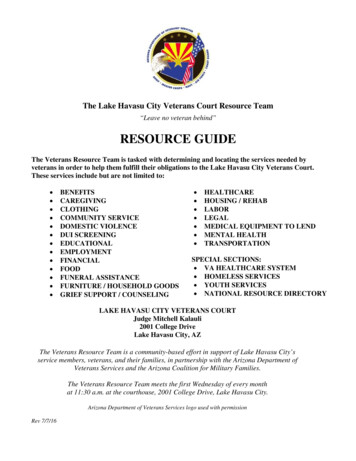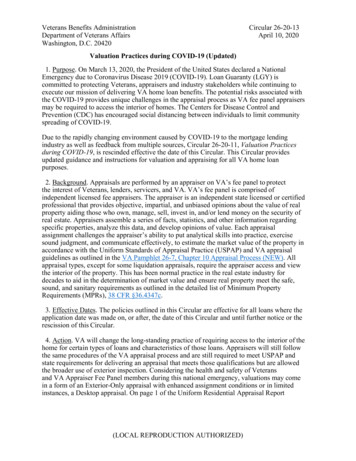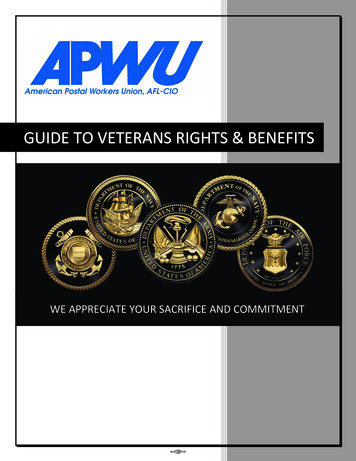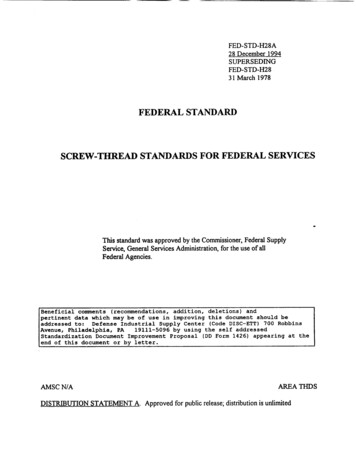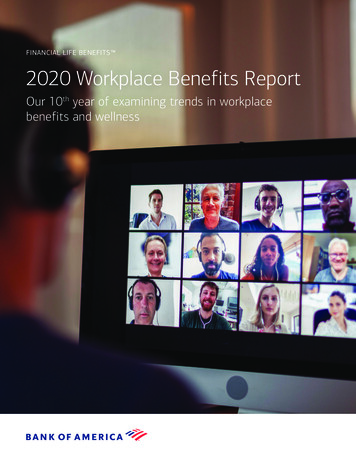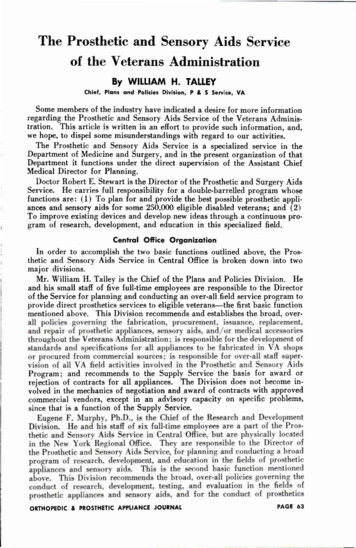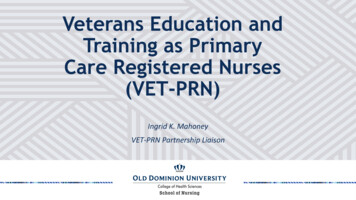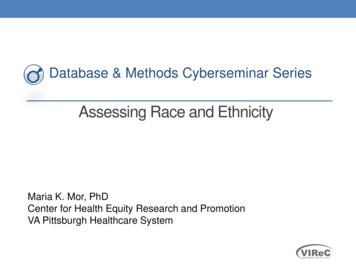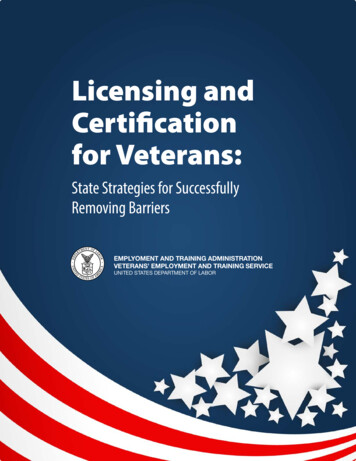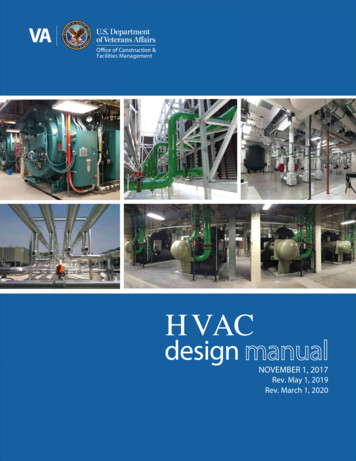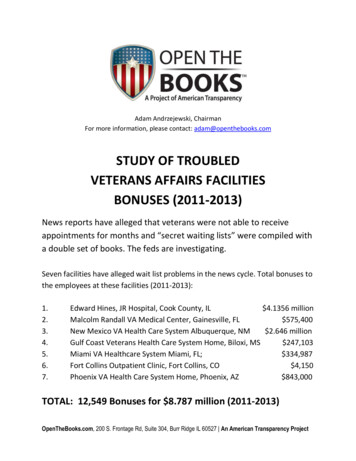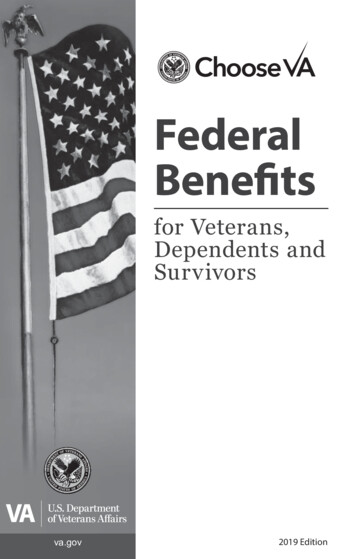
Transcription
FederalBenefitsfor Veterans,Dependents andSurvivorsva.gov2019 Edition
Phone NumbersVeterans Crisis Line. 1-800-273-8255 and Press 1Bereavement Counseling. 1-202-461-6530Civilian Health and Medical Program (CHAMPVA). 1-800-733-8387Caregiver Stipend 1-877-733-7927Debt Management Center 1-800-827-0648Education. 1-888-442-4551Foreign Medical Program 1-303-331-7590Spina Bifida Program 1-888-820-1756Camp Lejeune Family Member Program 1-866-372-1144Headstones and Markers. 1-800-697-6947Health Care. 1-877-222-8387Homeless Veterans. 1-877-424-3838Home Loans. 1-888-827-3702Life Insurance. 1-800-669-8477National Cemetery Scheduling Office 1-800-535-1117Pension Management Center 1-877-294-6380Presidential Memorial Certificate Program. 1-202-565-4964Telecommunication Device for the Deaf (TDD). 1-800-829-4833VA Benefits. 1-800-827-1000VA Combat Call Center 1-877-927-8387Women Veterans. 1-877-222-8387Web SitesMental Health. www.mentalhealth.va.govBurial and Memorial Benefits www.cem.va.govCaregiver Support www.caregiver.va.govCHAMPVA ts/champva/index.aspCommunity Care https://www.va.gov/communitycare/eBenefits www.ebenefits.va.govEducation Benefits. www.gibill.va.govEnvironmental Exposures. www.publichealth.va.gov/exposuresFederal Recovery Coordination Program www.va.gov/icbc/frcpHealth Care Eligibility www.va.gov/healthbenefitsHomeless Veterans www.va.gov/homelessHome Loan Guaranty www.homeloans.va.govLife Insurance. www.insurance.va.govMemorial Certificate .Program. www.cem.va.gov/pmc.aspMy HealtheVet www.myhealth.va.govNational Resource Directory www.nrd.govRecords. ing Servicemembers www.oefoif.va.govState Departments of Veterans Affairs www.va.gov/statedva.htmWomen Veterans. www.womenshealth.va.govVA Vet Centers www.vetcenter.va.govVA Home Page. www.va.govVA Benefit Payment Rates. www.vba.va.gov/bln/21/ratesVA Forms. www.va.gov/vaformVocational Rehabilitation and Employment. www.vetsuccess.gov
IntroductionVeterans of the United States armed forces may be eligible for a broadrange of benefits and services provided by the U.S. Department ofVeterans Affairs (VA). These benefits are codified in Title 38 of the UnitedStates Code. This booklet contains a brief overview of the most commonly sought information concerning Veterans benefits and services. Forthe most accurate information, Veterans and family members should visitthe websites provided within this publication as regulations, payments,and eligibility requirements are subject to change. For additional information, please visit www.va.gov. To find the nearest VA facility, go tohttps://www.va.gov/landing2 locations.htm.General Eligibility: Eligibility for most VA benefits is based upon dischargefrom active military service under other than dishonorable conditions.Active service means full-time service, other than active duty for training, as a member of the Army, Navy, Air Force, Marine Corps, Coast Guard,or as a commissioned officer of the Public Health Service, EnvironmentalScience Services Administration or National Oceanic and AtmosphericAdministration, or its predecessor, the Coast and Geodetic Survey.Eligible Wartime Periods: Certain VA Benefits Require WartimeService. For information on eligible wartime periods please visit sp. Dishonorable andbad conduct discharges issued by general courts-martial may bar VAbenefits. Veterans in prison must contact VA to determine eligibility. VAbenefits will not be provided to any Veteran or dependent wanted foran outstanding felony warrant.Important Documents: In order to expedite benefits delivery, Veteransseeking a VA benefit for the first time must submit a copy of their service discharge form (DD-214, DD-215, or for World War II Veterans, a WD form), whichdocuments service dates and type of discharge, or provides full name, military service number, and branch and dates of service. The Veteran’s servicedischarge form should be kept in a safe location accessible to the Veteran andnext of kin or representative.The following documents will be needed for claims processing relatedto a Veteran’s death: Veteran’s marriage certificate for claims of a surviving spouse or children; Veteran’s death certificate if the Veteran did notdie in a VA health care facility; children’s birth certificates or adoptionpapers to determine children’s benefits; or Veteran’s birth certificate todetermine parents’ benefits. For information and updates on VA benefits
and services, follow us on Facebook at http://www.facebook.com/VeteransBenefits and/or Twitter s is a joint VA/Department of Defense (DoD) Web portal thatprovides resources and self-service capabilities to service members,Veterans, and their families to apply, research, access, and manage theirVA and military benefits and personal information through a secureInternet connection.Through eBenefits Veterans can: apply for benefits, view their disability compensation claim status, access official military personnel documents (e.g., DD Form 214, Certificate of Release or Discharge from ActiveDuty), transfer entitlement of Post-9/11 GI Bill to eligible dependents(service members only), obtain a VA-guaranteed home loan Certificateof Eligibility, and register for and update direct deposit information forcertain benefits. New features are added regularly.Accessing eBenefits: The portal is located at www.ebenefits.va.gov.Service members or Veterans must register for an eBenefits account atone of two levels: Basic or Premium. A Premium account allows the userto access personal data in VA and DoD systems, as well as apply for benefits online, check the status of claims, update address records, and more.The Basic account allows access to information entered into eBenefits bythe service member or Veteran only. Basic accounts cannot access VA orDoD systems.Reporting Fraud: Help VA’s Secretary ensure integrity by reporting suspected fraud, waste or abuse in VA programs or operations.Report Fraud to:VA Inspector General Hotline810 Vermont Avenue, NW Washington, D.C. 20420E-mail: vaoighotline@va.govVAOIG hotline: 1-800-488-8244Fax: (202) 495-5861ContentsHealth Care Benefits Burial and Memorial Benefits 11463
Chapter 1Health Care 1Health CareMore information on VA health care is available at the following resources:www.va.gov/health, www.va.gov/healthbenefits and VA Health Benefitstoll-free 1-877- 222-VETS (8387) Monday through Friday between 8:00 a.m.and 8:00 p.m. EST.Basic Eligibility: A person who served in the active military, naval, or airservice and who was discharged or released under conditions other thandishonorable may qualify for VA health care benefits including qualifyingReserve and National Guard members.Minimum Duty Requirements: Veterans who enlisted afterSeptember 7, 1980, or who entered active duty after October 16, 1981,must have served 24-continuous months or the full period for whichthey were called to active duty in order to be eligible. This minimum dutyrequirement may not apply to Veterans discharged for hardship, early outor a disability incurred or aggravated in the line of duty.Enrollment: Veterans can complete applications for enrollment in VAhealth care by using one of the options below: To apply by phone, call 1-877-222-VETS (8387) Monday throughFriday between 8 a.m. and 8 p.m. EST. VA staff members willcollect the needed information and process the enrollmentapplication for an enrollment determination. When applying online at va.gov, Veterans fill out the applicationand electronically submit it to VA for processing. VA will searchfor your supporting documentation through its electronicinformation systems and will contact you if it is unable to verifyyour military service. The application form can also be downloaded from ntroduction. Mail the completed form to: Health Eligibility Center ATTN: Enrollment EligibilityDivision 2957 Clairmont Road Suite 200 Atlanta, GA 30329-1647 Apply in person at any VA health care facility or VA regional office.Once enrolled, Veterans can receive health care at VA health carefacilities anywhere in the country.The following four categories of Veterans are not required to enroll, butare urged to do so to permit better planning of health resources:1. Veterans with a service-connected disability rated at 50 percentor more.
2 Health CareChapter 12.Veterans seeking care for a disability the military determined wasincurred or aggravated in the line of duty, but which VA has notyet rated, within 12 months of discharge.3.Veterans seeking care for a service-connected disability only.4.Veterans seeking registry examinations (ionizing radiation, AgentOrange, Gulf War/Operation Enduring Freedom/ Operation IraqiFreedom/ Operation New Dawn (OEF/OIF/OND) depleted uranium,airborne hazards and Airborne Hazards and Open Burn Pit Registry).Priority Groups: During enrollment, each Veteran is assigned to a prioritygroup. VA uses priority groups to balance demand for VA health care enrollment with resources. Changes in available resources may reduce the numberof priority groups VA can enroll. If this occurs, VA will publicize the changesand notify affected enrollees. A description of priority groups follows:Group 1: Veterans with service-connected disabilities rated 50percent or more; Veterans determined by VA to be unemployable due toservice-connected conditions; and Veterans who have been awarded theMedal of Honor.Group 2: Veterans with service-connected disabilities rated 30 or40 percent.Group 3: Veterans who are former Prisoners of War; Veterans awarded the Purple Heart medal; Veterans whose discharge was for a disabilityincurred or aggravated in the line of duty; Veterans with VA service-connected disabilities rated 10 or 20 percent; and, Veterans awarded specialeligibility classification under Title 38, U.S.C., § 1151, “benefits for individuals disabled by treatment or vocational rehabilitation.”Group 4: Veterans who receive increased compensation or pensionbased on their need for regular aid and attendance or by reason of beingpermanently housebound; and, Veterans determined by VA to be catastrophically disabled.Group 5: Nonservice-connected Veterans and non-compensableservice-connected Veterans rated by VA as 0-percent disabled and whohave an annual income below the VA’s geographically-adjusted incomelimit (based on your resident ZIP code); Veterans receiving VA Pensionbenefits; and Veterans eligible for Medicaid benefits.Group 6: Compensable 0 percent service-connected Veterans;Veterans exposed to ionizing radiation during atmospheric testing orduring the occupation of Hiroshima and Nagasaki. Project 112/SHADparticipants; Veterans who served in the Republic of Vietnam betweenJan. 9, 1962 and May 7, 1975; Veterans who served in the Southwest Asia
Chapter 1Health Care 3theater of operations from Aug. 2, 1990, through Nov. 11, 1998; Veteranswho served in a theater of combat operations after Nov. 11, 1998, asfollows: Veterans discharged from active duty on or after Jan. 28, 2003,for five years post discharge; and Veterans who served on activeduty at Camp Lejeune for at least 30 days between Aug.1, 1953, andDec. 31, 1987. Currently enrolled Veterans and new enrollees who servedin a theater of combat operations after Nov.11, 1998 and those who weredischarged from active duty on or after Jan. 28, 2003, are eligible for theenhanced benefits for five years post dischargeNote: At the end of this enhanced enrollment priority group placementtime period, Veterans will be assigned to the highest priority group theireligibility for which their status at that time qualifies.Group 7: Veterans with gross household income below the geographically-adjusted VA income limit for their resident location and, whoagree to pay copayments.Group 8: Veterans with gross household incomes above VA nationalincome limit and the geographically-adjusted income limit for theirresident location and, who agree to pay copayments. Veterans eligible forenrollment: Noncompensable 0-percent service-connected and are: Subpriority a: Enrolled as of Jan. 16, 2003, and who have remainedenrolled since that date and/or placed in this subpriority due tochanged eligibility status. Subpriority b: Enrolled on or after June 15, 2009, whose income exceeds the current VA national income limits or VA national geographic income limits by 10 percent or less Veterans eligible for enrollment:nonservice-connected and: Subpriority c: Enrolled as of Jan. 16, 2003, and who remainedenrolled since that date and/ or placed in this subpriority due tochanged eligibility status. Subpriority d: Enrolled on or after June 15, 2009 whose incomeexceeds the current VA national income limits or VA national geographic income limits by 10 percent or less Veterans NOT eligible forenrollment: Veterans not meeting the criteria above: Subpriority e: Noncompensable 0-percent service-connected(eligible for care of their service-connected condition only).Subpriority f: Nonservice-connectedVA’s income limits change annually and current levels can be located Year 2019.
4 Health CareChapter 1The VA MISSION ActOn June 6, 2018, the President signed the VA Maintaining InternalSystems and Strengthening Integrated Outside Networks Act (MISSIONAct) of 2018. This law strengthens VA’s ability to deliver trusted, easy toaccess, high quality care at VA facilities, virtually through telehealth, andin your community. The law makes several improvements to VA care thatbegin on June 6, 2019. Under the MISSION Act, VA will: Continue to provide you with an excellent healthcare experience Deliver the right care, at the right time, at the right place Continue to offer care through telehealth in your home, in aVA facility, or in the community Provide more options for health care, including communitycare and urgent/walk-in careEligibility for Community CareCommunity care is changing on June 6, 2019. Under the MISSION Act,there are six different eligibility criteria for community care. Meeting anyone of these criteria for the specific care you need means you are eligibleto elect to receive that care either through direct VA care or a communityprovider in VA’s network: The specific care you need is not provided by VA at any facility You reside in a U.S. state (AK, HI, or NH) or territory (Guam,American Samoa, Northern Mariana Islands, or U.S. VirginIslands) that does not have a full-service VA medical facility ”Grandfathered” eligibility based on residence and the 40-mileeligibility criterion from the Choice program The specific care you need is not available within designatedaccess standards You and your referring clinician decide it is in your bestmedical interest to receive the specific care you need inthe community VA has designated the VA medical service line delivering thespecific care you need as not providing care that complieswith VA’s standards for qualityUrgent CareVA will offer an urgent/walk-in care benefit for minor injuries and illnesses, such as pink eye or ear infections. To be covered by this benefit,you must be enrolled in the VA health care system and have received carefrom VA within the 24 months prior to seeking this care to be eligible forthis benefit.
Chapter 1Health Care 5Eligible Veterans can seek this care from an urgent care facility or walk-inretail health clinic that is part of VA’s community provider network, but notall urgent care facilities or walk-in retail health clinics are in VA’s network.As VA implement the MISSION Act, Veterans should continue to talk totheir VA health care team or scheduler to get the care they need. For moreinformation, please visit http://missionact.VA.gov.VA’s income limits change annually and current levels can be located lYear 2019.Community CareVA offers a variety of health care and services for Veterans through community providers outside of VA. Veterans may be eligible to receive carefrom a provider in their community when VA cannot provide the carethey need. This type of care is known as “community care,” and for eligibleVeterans, is provided on behalf of and paid for by VA.These services are provided to Veterans based on certain conditions andeligibility requirements, and in consideration of a Veteran’s specific needsand circumstances. Although some changes have taken place with community care recently, Veterans continue to have access to this type of care.The process starts at your VA medical facility.If you have a question about your specific care needs, contact your VAmedical facility. Accessing Community Care begins with scheduling anappointment with your VA provider (doctor). To find the VA facility closestto you access the facility directory at https://www.va.gov/directory/guide/home.asp. For more information on Community Care programs visit, or call1-866-606-8198.Meeting the Unique Needs of Women Veterans: VA staff delivers the highest quality health care in a setting that ensures privacy, dignity, and sensitivity.Local VA facilities offer a variety of services, including women’s gender-specifichealth, screening and disease prevention and routine gynecologic services.Women Veterans are potentially eligible to receive care provided in thecommunity when authorized by VA; however, the decision to use suchcare is left to the facility providing care. By law, purchased care can onlybe provided when the treating facility cannot provide the care required orbecause of geographical inaccessibility.
6 Health CareChapter 1Contact a local VA facility’s Women Veterans Program Manager for moreinformation on available services, call 1-855-VA-WOMEN (1-855-829-6636)or visit www.womenshealth.va.gov/.Lesbian Gay Bisexual and Transgender (LGBT) Veterans: LGBTVeterans are eligible for the same VA benefits as any other Veteran andwill be treated in a welcoming environment. Transgender Veterans willbe treated based upon their self-identified gender, including room assignments in residential and inpatient settings. Same-sex couples: VAlaunched a website to inform Veterans and beneficiaries of the recentchanges in the law and procedures involving same-sex marriages.Veterans can learn more about VA’s guidance regarding same-sex marriages at www.va.gov/opa/marriage.Military Sexual Trauma (MST): MST is the term that VA uses to refer tosexual assault or repeated, threatening sexual harassment occurring during a Veteran’s military service. VA has expanded eligibility for Veterans inneed of mental health care due to sexual assault or sexual harassment toReservists and National Guard members participating in weekend drill. Toreceive free treatment related to MST, Veterans do not need a VA serviceconnected disability. Veterans do not need to have reported the incidentwhen it happened or have other documentation that it occurred. Thereare no length-of-service requirements to receive care, and some Veteransmay be able to receive free MST-related care even if they are not eligiblefor other VA care. Veterans can learn more about VA’s MST-related servicesonline at www.mentalhealth.va.gov/msthome.asp.OEF/OIF/OND Care Management: Each VA medical center has anOperation Enduring Freedom/Operation Iraqi Freedom/Operation NewDawn (OEF/OIF/OND) Care Management team in place to coordinatepatient care activities and ensure that Veterans are receiving patient‑centered, integrated care and benefits. Veterans who served in a theaterof operations after Nov. 11, 1998, are eligible for an extended period ofeligibility for health care for five years after their discharge. In the caseof multiple call-ups, the five-year enrollment period begins on the mostrecent discharge date. This special eligibility includes cost-free health careservices and nursing home care for conditions possibly related to militaryservice and enrollment in Priority Group 6 or higher for five years fromtheir date of discharge or release from active duty, unless they are eligiblefor enrollment in a higher priority group. More information for connecting with OEF/OIF/OND Care Management teams can be found at www.oefoif.va.gov.
Chapter 1Health Care 7Tax Credit: Veterans who are enrolled with VA for their health caremeet the standard for minimum health care coverage; therefore, theyare not eligible for assistance to lower their cost of health insurancepremiums if they chose to purchase additional health insuranceoutside of their VA health care coverage. Remember, Veterans cannotreceive a tax credit for themselves when enrolling within the marketplace, if they are currently enrolled with VA for their health care. Forthe latest information about VA and the health care law, visit www.va.gov/health/aca/FAQ.asp or call 1-877-222-VETS (8387).Financial Assessment: Most Veterans not receiving VA disabilitycompensation or pension payments must provide a financial assessment upon initial application to determine their eligibility forfree medical care, medications and/or travel benefits. This financialinformation also may be used to determine the Veteran’s enrollmentpriority group.For more information, visit www.va.gov/healthbenefits/cost/financial assessment.asp, call toll-free 1-877-222-VETS (8387) Mondaythrough Friday between 8 a.m. and 8 p.m. EST or contact the enrollment coordinator at your local VA medical facility. VA’s income limitsare located at ar 2019.VA no longer requires enrolled non-service connected and 0-percentnon-compensable service connected Veterans to provide their financialinformation annually. An assessment will continue to be collected fromVeterans at the time of application for enrollment. In lieu of the annualfinancial reporting, VA will confirm the Veteran’s financial informationusing information obtained from the Internal Revenue Service and SocialSecurity Administration.Medical Services and Medication Copayments: While many Veteransqualify for free health care based on a VA compensable service-connected condition or other special eligibilities, most Veterans are required tocomplete a financial assessment at the time of enrollment to determineif they qualify for free health care services. Veterans whose incomeexceeds the VA income limits as well as those who choose not to complete the financial assessment at the time of enrollment must agree topay required copayments for care to become eligible for VA healthcareservices. For more information on medical services and copays, .asp.
8 Health CareChapter 1Private Health Insurance Billing: Veterans with private health insurancemay choose to use these sources of coverage as a supplement to their VAbenefits. Veterans are not responsible for paying any remaining balanceof VA’s insurance claim not paid or covered by their health insurance. Bylaw, VA is obligated to bill health insurance carriers for services providedto treat a Veteran’s nonservice-connected conditions. Veterans are askedto disclose all relevant health insurance information to ensure currentinsurance information is on file, including coverage through a spouse.Any payment received by VA may be used to offset “dollar for dollar” aVeteran’s VA copay responsibility. Funds that VA receives from third partyhealth insurance carriers go directly back to VA medical center’s operational budget. That money can be used to hire more staff or buy medicalequipment to improve Veterans healthcare. Enrolled Veterans can provideor update their insurance information by:1. Using the online Health Benefits Renewal form (10-10-EZR) /introduction.2.Calling 1-877-222-VETS (8387) Monday through Friday between8 a.m. and 8 p.m. EST.3.Presenting their health insurance card to the clinic clerk or usingthe self-service kiosks available at their local VA health care facility. VA health care is NOT considered a health insurance plan.Reimbursement of Travel Costs: Eligible Veterans and non-Veteransmay be provided mileage reimbursement or, when medically indicated,special mode transport (e.g., wheelchair van, ambulance), when travel isin relation to VA medical care. Mileage reimbursement is 41.5 cents permile and is subject to a deductible of 3 for each one-way trip and 6 fora round trip; with a maximum deductible of 18 or the amount after sixone-way trips (whichever occurs first) per calendar month. The deductible may be waived when travel is; in relation to a VA compensation orpension examination; by a special mode of transportation; by an eligiblenon-Veteran; or will cause a severe financial hardship, as defined by current regulatory guidelines.Eligibility: A Veteran may be eligible for beneficiary travel services if thefollowing criteria are met: have a service-connected (SC) rating of 30 percent or more, or are traveling for treatment of a SC condition, or receive a VA pension, or your income does not exceed themaximum annual VA pension rate, or
Chapter 1 Health Care 9are traveling for a scheduled compensation or pension, or if nototherwise eligible as noted above and;have a vision impairment, spinal cord injury or disorder, or adouble or multiple amputation who’s travel in connection withcare provided through a VA special disabilities rehabilitationprogram (including programs provided by spinal cord injury centers, blind rehabilitation centers and prosthetics rehabilitationcenters) if such care is provided on an in-patient basis or duringa period in which you are provided with temporary lodging at afacility of the Department to make such care more accessible.Veterans may qualify for special mode transportation (ambulance,wheelchair van, etc.) if they meet one of the eligibility criteria in the listabove, and have a medical condition requiring an ambulance or a speciallyequipped van as determined by a VA clinician, and the travel is pre‑authorized (authorization is not required for emergencies if a delay wouldbe hazardous to life or health). More information on Beneficiary Travel isavailable at: www.va.gov/healthbenefits/vtp/beneficiary travel.asp.Veteran Health Registries: Certain Veterans can participate in a VAhealth registry and receive free evaluations. VA maintains health registriesto provide special
810 Vermont Avenue, NW Washington, D.C. 20420 E-mail: vaoighotline@va.gov VAOIG hotline: 1-800-488-8244 Fax: (202) 495-5861 Contents Health Care. 1 Benefits 14 Burial and Memorial Benefits. 63. Chapter 1 Health Care 1 Health Care More information o
